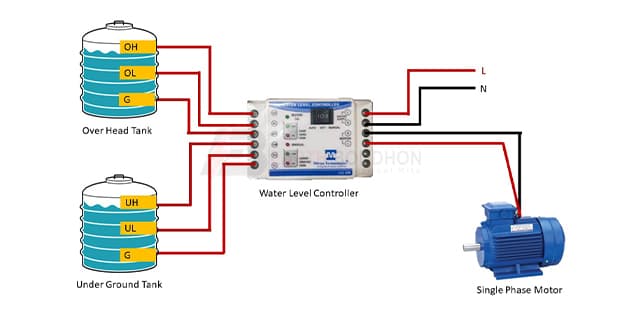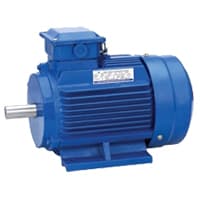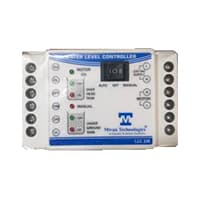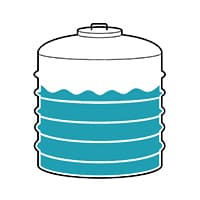Automatic Water Level Controller Wiring:
This diagram shows how to make an Automatic Water Level Controller Wiring. In this circuit, we use a total of 2 water tanks, a water level controller, and a single-phase motor. First, we need to input power to the water level controller, then input power to the single-phase motor from the water level controller. And then we need to input the level connection to the water tank from the water level controller. Now it is ready for use. If you want to know more about this circuit please check our youtube video below the post.
Advertisements
Components needed For this Project:
You can get the components from any of the sites below:
- Single Phase Motor (1 HP) [See Buy Click Amazon]
- Water Level Controller [See Buy Click Amazon]
- Water Tank 1000L [See Buy Click Amazon]
*Please note: These are affiliate links. I may make a commission if you buy the components through these links. I would appreciate your support in this way!
Advertisements
Components used to make the automatic Water Level Controller Wiring:
A Single-Phase Motor is an Electrically-Powered Rotary Machine That Can Turn Electric Energy into Mechanical Energy. It Works by Using a Single-Phase Power Supply. Single-phase Motors Are Used in Equipment And Machines That Are Smaller in Size And Require Lower Horsepower. This Includes Equipment Such As Refrigerators, Pumps, Compressors, Fans, and Portable Drills. Single-phase motors Have a Similar Construction to The 3-phase Motor, Including an AC Winding That is Placed on The Stator And Short-Circuited Conductors That are Placed in a Cylindrical Rotor.
02. Water Level Controller:
A Water Level Controller Helps Save Money by Limiting The Waste of Water and Electricity circuit diagram. These Devices Accurately Regulate how Much Energy is Used to Protect Against any Unnecessary Water/Electricity Usage. Water Level Controllers That Automatically Adjust The Water Level save Energy. They do it by Automatically Turning off the Motor When the Tank is full and When There is no Water Flow to The Tank. This Means That less Water and Energy are Utilized to Control a Water Supply.
Water tank storage is the storage of water, which we use for domestic, agricultural, and industrial purposes. Water storage tanks come in a variety of materials, shapes, and sizes depending on the intended use of the tank. A water storage tank is main role is to store water before it can be used for drinking, washing, cleaning, etc. - but many storage tanks are more complicated than they seem. There are some common types of water storage tanks that we use in homes. 1. Well-pressure tank 2. The thermal expansion tank 3. Reverse osmosis tank.
Thank You for visiting the website. Keep visiting for more Updates.
Frequently asked questions
The single most of common reason a pump controller fails is due to a build-up of 'muck' in the internals of the controller. Typically, tank water collected off a roof catchment contains bacteria which with the addition of summer heat can develop bacterial growth.
Pump controllers monitor motor performance and can detect potential issues, such as low water levels and motor overload. By responding to these issues promptly, the controller can protect the pump from damage and minimize the risk of system failure.
Pump Control Systems and motor controllers provide a range of functions for single and multiple pump installations in various applications. Functions may include start / stop control, timers, alarms, error reporting, and the setting and management of operational parameters such as pump speed or output pressure.
Water level control devices are basically composed of 3 components: a Level Controller, an Electrode Holder, or Electrodes.
A water level of the substitutes a plastic tube for a body of water. One end of the tube is fixed at a reference of the height while you move the other end to different locations. As long as the water stabilizes at the same of height in both legs of the tubing, you know the 2 ends share the same elevation.
Read more Single Phase Wiring
What is a kilowatt-hour (kWh) | kwh formula | What does kwh mean
Introduction to Electrical Units and CircuitskW and kWh on your electricity bill As your home uses electricity during...
What is the Difference Between kVA | What does KVA mean | kVA formula
Difference Between KVA ExplainedWhat does KVA Mean? There are technical terms aplenty when it comes to generators, and...
Power Factor | Power Unit | Energy | Electricity Unit
Power factor definition | Calculating Power FactorPower Factor Values In a purely resistive circuit, the power factor...




0 Comments